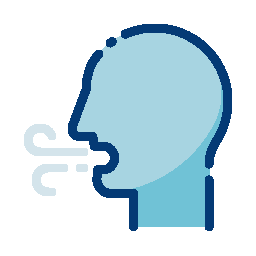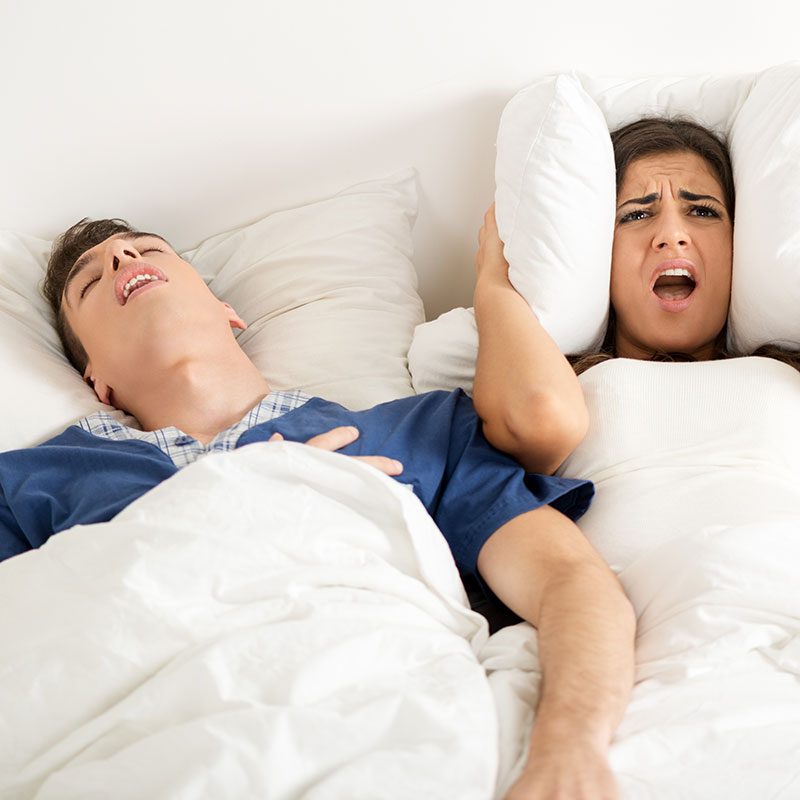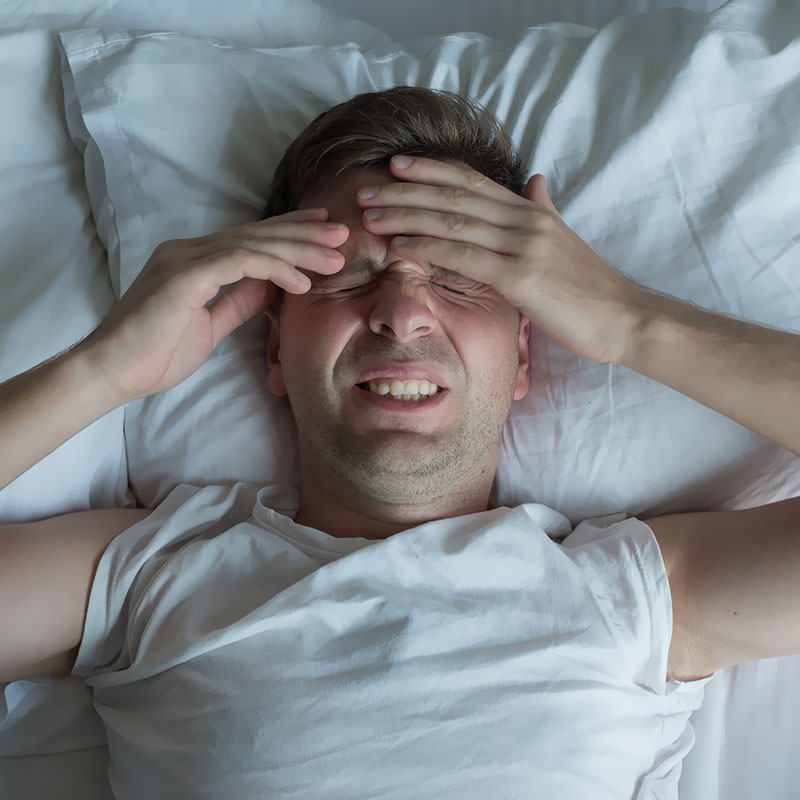More About
Sleep Apnea

More About Sleep Apnea
What is Sleep Apnea?
The word apnea literally means “cessation of breath.”
Sleep apnea is a disorder characterized by the complete or partial cessation of breathing during sleep, despite attempts to breathe. Persons with sleep apnea typically make periodic gasping or snorting noises resulting in interrupted sleep. These interruptions in breathing, called apneas, are associated with:
• Daytime sleepiness
• Inability to stay alert and process information
• Increased risk of heart attack
• Mood changes and irritability
The most common symptom of sleep apnea is excessive sleepiness during the day which is caused by frequently interrupted nighttime sleep. Studies by the World Health Organization (WHO) have shown that insufficient sleep has been linked to the development and management of a number of chronic diseases and conditions including:
• Diabetes
• Cardiovascular disease
• Obesity
• Depression
• Sexual dysfunction
• Accidents and even death
In Canada, from 2009 to 2016, Canadians reported a doubling of diagnose of sleep apnea from 3% – 6.4% of adults over 18 years of age. Older people are three times as likely to report sleep apnea and males are twice as likely to report sleep apnea/snoring symptoms. Females are more likely to report feeling tired, fatigue or insomnia.
Please see the following link for a more complete review of Sleep Basics from the Cleveland Clinic, Statistics Canada, the ASA and the American Association of Dental Sleep Medicine.
Who has Sleep Apnea?
OSA occurs as a result of certain physiological conditions such as:
• Obesity
• Facial disharmony (e.g. a retracted lower jaw)
• Small mouth
• An enlarged tongue
• Poor muscle tone
• Orthodontics
• Social factors such as excessive alcohol consumption
As an example, a person who is older, overweight and has a large tongue may suffer from sleep apnea. At night, during sleep, the back of the tongue compresses the airway in people with OSA, thereby causing a total or partial air blockage. Apnea sufferers experience periods of silence because they aren’t breathing followed by a gasping noise when they try to start breathing again. This differs from snoring suffers who usually have a slow rhythmic constant noise. Think of a chain saw.
While the condition mainly occurs in adult males ages 49 and older, neck size, weight, ethnicity, family history and sleep position are also contributing factors.
People with severe or moderate sleep apnea have more episodes when they sleep on their back By learning to sleep on their right or left side patients are able to reduce these episodes. Right side sleeping is preferable but either is better than sleeping on the back.
If you suffer from sleep apnea, your physician may initially recommend a change in lifestyle and diet. These changes may include: weight loss if you are overweight, adjusting your sleep position by sleeping on the side instead of the back, reducing your alcohol intake and use of sedatives. If the condition persists despite these changes, your physician will recommend other treatment options.
Diagnosing Sleep Apnea
Sleep apnea is a potentially life-threatening medical condition. If you suspect that you suffer from the
condition, our Qualified Dentist will conduct an examination and discuss the diagnostic screening process and options with you.
We will complete an initial consultation and in conjunction with your Doctor, a referral will be made to a sleep clinic for a sleep test. Upon recommendation by the sleep doctor of an oral appliance, we will review:
• Your medical and dental history
• Tooth, gum, jaw joint, hygiene, and radiographic examination
• A full disclosure of possible challenges and resolutions
A definitive diagnosis of sleep apnea can be made with a sleep study called Polysomnography (PSG). This is conducted during a visit to a sleep lab, where a sleep technician will monitor your sleep to determine snoring, breathing pauses, related oxygen levels and leg movements. The test is then read by the Physician and either an oral appliance or CPAP will be recommended.
Upon completion of the study and recommendation of a Health Canada approved appliance, the patient will be fitted with the appropriate device. Once the appliance has been adjusted to the
patient’s optimum relief of symptoms, a home study can be performed to confirm an improvement.
With home testing monitors, we can confirm that the appliance is relieving the patient’s symptoms as best as possible. Is the patient more alert? Are they snoring less? Do they feel more rested?
Once we have confirmed the effectiveness of the appliance, the patient is then referred back to the Sleep Clinic for a full laboratory sleep study.
Please use the following link to get more in-depth information from the American Academy of Dental
Sleep Medicine:
Treatment Options
There are many choices for the treatment of snoring and sleep apnea which include:
CPAP, nasal pharyngeal surgery, hypoglossal nerve stimulation, positional therapy, mandibular advancing appliances and tongue retaining devices. Upon examination of the nasal pharyngeal airway, there can be a restricted area which prevents air from travelling to your lungs. Enlarged turbinate bones, deviated septum, overgrowth of nasal tissue and polyps all restrict air from entering from your nose to the back of your throat. In these cases, a consultation with an ENT surgeon would be arranged for further investigation and treatment.
When we interpret your overnight sleep study ( PSG ), the number of times you stop breathing ( apneas ) are broken down by your sleep position. If you snore or have more apneas when you are on your back, we have strategies to try and retrain you to be a side sleeper.
To make a MAD, the patient needs at least 8 firm healthy teeth per jaw. This is not always possible due to tooth loss, gum disease or bony ‘bumps’ in the mouth. Other treatments include, a tongue retaining device which pulls the tongue forward out of the mouth while you sleep, or a device that looks like 2 full dentures. This is only possible when the patient has large firm ridges.
Hypoglossal Nerve Stimulation is a surgical procedure that implants a type of ‘Pacemaker” to stimulate the Hypoglossal nerve and allows you to keep your airway open in specific patients.
We will discuss any appropriate treatments at a consultation appointment.
Oral Appliance Advantages
Advantages of Mandibular Advancing Devices (MAD):
-
Easy to transport (no electric wires, tubing, or masks)
-
Small vs CPAP machine
-
No constant replacement of masks and tubing
-
No sore spots or dry patches, due to straps against your face
-
Easy to turn over in bed
-
Easy to get up to go to the bathroom and go back to sleep
-
No irritating noises from CPAP machine, mask, or tubing
-
Easy to clean appliance with Polident or similar products
Disadvantages:
-
Not appropriate for severe sleep apnea unless the patient is unwilling or unable to tolerate CPAP
-
Can cause your teeth to move
-
Can cause bite changes
-
Possible short term muscle soreness
-
Possible breakage of previously treated teeth.
Please use the following links to get more in-depth information from the American Academy of Dental Sleep Medicine:

What is Snoring?
Snoring can be defined as the rhythmic noise a patient makes when they inhale or exhale in the absence of any apnea, hypopneas, choking or waking.
Snoring occurs in 10 – 50 % of western populations. It has been suggested that this prevalence increases up to the age of 60 years of age and then decreases after that. It is more common in males than females, and increases with obesity, sinus issues, anatomical abnormalities and ethnicity.
If the patient exhibits a constant rhythmic sound, similar to sawing wood, this may indicate a snoring problem. Although not medically life threatening in itself, snoring is certainly life disturbing to the sleep partner as well other members of the family.

Types of Sleep Apnea
Central Sleep Apnea is rare but sometimes occurs in persons who have suffered a head injury or stroke. CSA takes place in a region of the brain where the nerves that regulate breathing no longer function normally and cause breathing to be impaired. It occurs because the brain fails to instruct the body to breath. The person can breathe, but doesn’t.
During an episode of Obstructive Sleep Apnea (OSA) the upper airway repeatedly collapses during sleep, preventing air from reaching the lungs. Breathing usually resumes with a loud gasp, snort, or body jerk. These episodes can occur many times during the night and the danger increases as the number of events escalate.
OSA episodes also interfere with a sound night’s rest which is essential for the body and mind to function efficiently. Loss of oxygen to certain vital organs can result in heart attack and stroke among other problems. A new research paper even suggests a link between hearing loss and sleep apnea.
The final form is Mixed Sleep Apnea which occurs when a person experiences both central and obstructive apnea. This is extremely rare.
Symptoms of Sleep Apnea
Episodes may include restless legs syndrome where the patient feels an urge to move their legs accompanied by an unpleasant feeling in their legs. The symptoms are worse during the evening and during periods of rest.
If you suffer from sleep apnea, common symptoms include:
• Excessive tiredness during the waking hours, including immediately after waking up
• Irritability
• High blood pressure
• The tendency to doze off while at work, driving or even during conversations
• Sexual dysfunction
• Depression
• High blood pressure
• Heart attack
• Stroke
Sleep apnea is a main predictor of coronary artery disease after smoking, severe obesity and diabetes.
Questions About Sleep Apnea
I can’t use my CPAP, what else can I do?
CPAP is the first line treatment of most sleep Doctors. When a patient is unable or unwilling to wear their CPAP device, the sleep Doctor can recommend an Oral Appliance as a good alternative. Many patients choose this option first, due to issues with claustrophobia, ill fitting masks and sleep partner intolerance to machine noise. A Qualified sleep trained Dentist should be involved in your proper examination and treatment. This includes the choice and production of the appropriate appliance. Proper annual checkups are a necessary part of your treatment.
What increases the risks of Sleep Apnea?
What are the symptoms?
Who suffers from Sleep Apnea?
Who can diagnose if I have Sleep Apnea?
Does insurance cover treatment costs?
Can children have Sleep Apnea?
Yes, children can have sleep apnea related to large adenoids, tonsils, throat and palate shape, as well as other factors. Children also may grind their teeth as a result of sleep disturbances. Some studies note a resulting lower IQ in children with untreated sleep apnea.
How is it treated?
What causes Sleep Apnea?
What is a sleep study?
A sleep study generates several records of activity during several hours of sleep, usually about six. Generally, these records include an electroencephalogram, or EEG, measuring brain waves; an electrooculogram, or EOG, measuring eye and chin movements that signal the different stages of sleep; an electrocardiogram, ECG, measuring heart rate and rhythm; chest bands that measure respiration; and additional monitors that sense oxygen and carbon dioxide levels in the blood and record leg movement.


